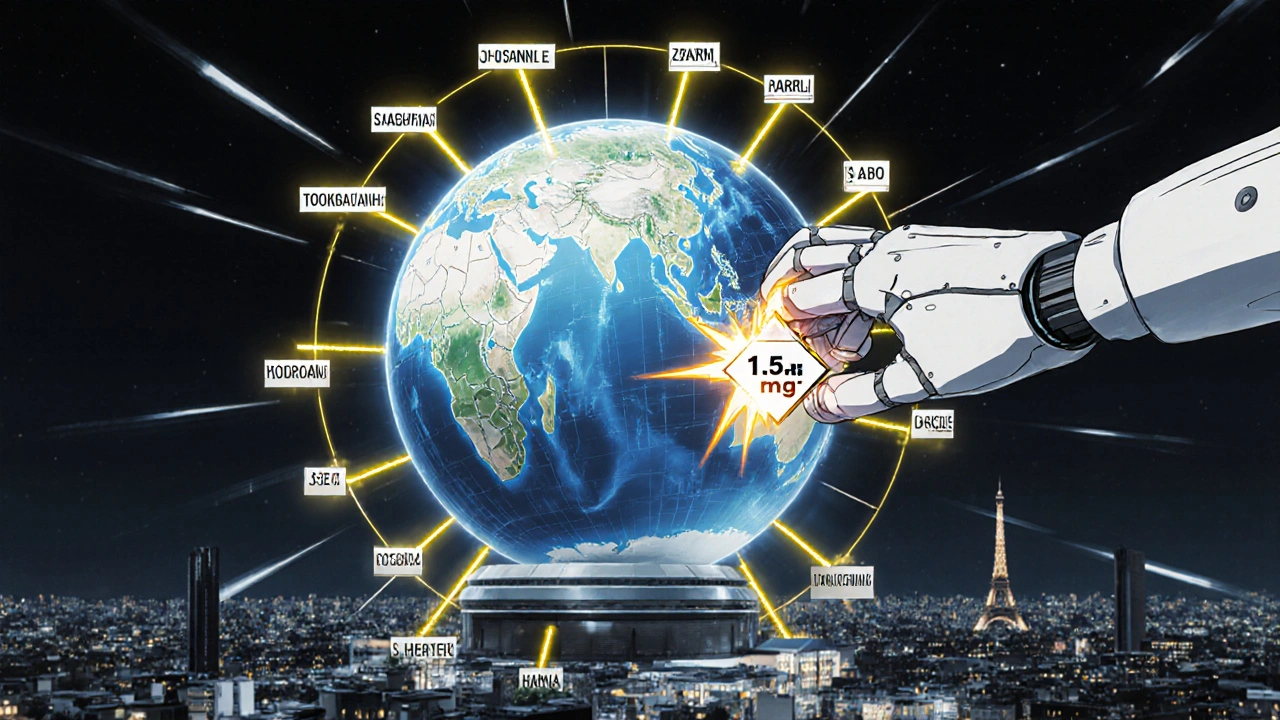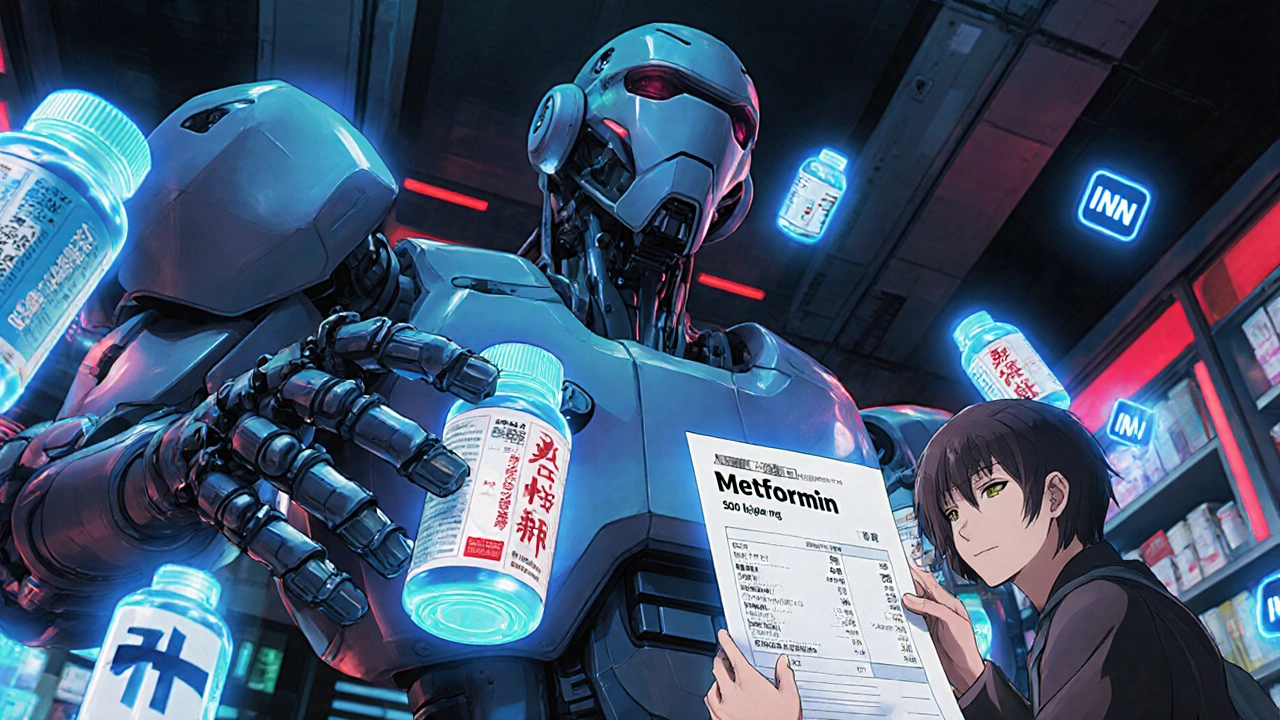Traveling abroad with prescription meds isn’t just about packing your bottle. It’s about making sure the pharmacy in Tokyo, Paris, or Dubai can actually read what you’re carrying-and give you the right medicine. A misread dosage or a confused brand name can mean the difference between relief and hospitalization. You might think Google Translate will do the trick, but it won’t. Not when the difference between Ambyen (a heart rhythm drug in the UK) and Ambien (a sleep aid in the U.S.) could kill someone. This isn’t hypothetical. It’s happened. And it’s why translating medication names and doses correctly matters more than ever.
Why Medication Names Vary So Much Around the World
The same pill can have five different names depending on where you are. That’s because drug manufacturers pick their own brand names for marketing, while the active ingredient stays the same. In the U.S., you might know ibuprofen as Advil or Motrin. In France, it’s Ibuprofène. In Poland, it’s Abfen. In Australia, it’s often sold under the generic name. The active ingredient-ibuprofen-is identical. But if you hand a pharmacist in Berlin a bottle labeled "Advil" and they don’t recognize it, they might refuse to refill it. Or worse, they might guess wrong. The World Health Organization created the International Nonproprietary Name (INN) system to fix this. INN gives every drug one global generic name. Ibuprofen is the INN. Paracetamol is the INN for what Americans call acetaminophen. But not every country uses INNs consistently. Some still rely on brand names. That’s why you need more than just the bottle. You need the active ingredient written down.What to Write Down Before You Travel
Don’t rely on memory. Don’t trust your phone’s notes app without a backup. Before you leave, make a clear, printed list of every medication you take. For each one, include:- The active ingredient (e.g., metformin, not Glucophage)
- The dosage (e.g., 500 mg, not "one pill")
- The frequency (e.g., "twice daily", not "morning and night")
- The purpose (e.g., "for high blood pressure")
- The brand name (just in case)
Dosage Formats Can Trick You
Dosage isn’t just about numbers. It’s about how they’re written. In the U.S., you’ll see "500 mg". In Germany, it’s "500 mg" too-but in some countries, they use commas instead of periods for decimals. So "1,5 mg" means 1.5 milligrams, not 1500 mg. A traveler once thought their prescription said "1,5 mg" of insulin and took 1500 mg by mistake. They ended up in the ER. Also, pill sizes are confusing. In the U.S., tablets are often labeled by total weight. In Japan, they sometimes list the active ingredient only. A pill labeled "500" in one country might mean 500 mg of active ingredient. In another, it might mean 500 mg total weight-including fillers. That’s why you need the active ingredient. Always. Never assume.
What Pharmacies Need to Fill Your Prescription
Foreign pharmacies don’t automatically trust foreign prescriptions. They need proof. Most will ask for:- A copy of your original prescription (with doctor’s signature)
- A letter from your doctor explaining why you need it
- Your passport or ID
- A translated version of the prescription
Professional Translation Services Are Worth It
Google Translate, DeepL, or even a bilingual friend? Don’t risk it. A 2023 study found that AI tools misinterpreted dosage instructions in 32% of cases. That’s one in three prescriptions. For something this critical, you need certified medical translators. Companies like RxTran and Stepes specialize in pharmacy translation. They use databases built from WHO INN standards, country-specific drug registries, and regulatory guidelines from the FDA, EMA, and others. They don’t just translate words-they convert formats. They know that "1 tab PO qd" in the U.S. becomes "1 comprimé par voie orale une fois par jour" in French. They also flag dangerous mix-ups. If you’re taking warfarin and your prescription gets translated as "heparin," they’ll catch it before it’s printed. These services aren’t cheap. Enterprise systems for pharmacies cost $3,500 a year. But for travelers, you can get a single prescription translated for under $50. It’s a small price to pay to avoid an emergency.What to Do If You Can’t Get a Translation
Sometimes, you’re stuck. You run out of meds in a small town. No translator nearby. No internet. Here’s what to do:- Find the active ingredient from your list. Write it clearly.
- Ask for the generic version. Say: "I need the medicine with [active ingredient]."
- Show the pill bottle. Point to the name and number.
- Ask them to check the INN database. Most large pharmacies have access.
- If they’re unsure, ask for a pharmacist-not just a clerk.

Regulations Are Changing-Fast
In the U.S., New York State requires pharmacies to provide translated labels in Chinese, Italian, Russian, and Spanish. California is adding more. The Department of Health and Human Services is pushing for translations in the top 15 languages spoken by non-English speakers in each state. By 2026, you might see multilingual labels everywhere. Hospitals and chain pharmacies are already using digital systems that auto-translate prescriptions. RxTran’s software integrates with pharmacy systems like PioneerRx and Frameworks. When a doctor e-prescribes from the U.S. to a clinic in Mexico, the system auto-generates the label in Spanish, with correct dosage and warnings. But this doesn’t help you if you’re traveling with a paper script. That’s why you still need your own translation.Real Stories: What Happens When Translation Goes Wrong
One traveler in Paris ran out of her blood thinner. She showed the pharmacist a bottle labeled "Warfarin 5 mg." He gave her a pill labeled "Coumadin 5 mg." Same thing, right? Wrong. The French pharmacy had no Coumadin. They gave her a different anticoagulant with a different half-life. She didn’t know. She took it. Two days later, she had a stroke. Another case: A man in Bangkok needed his antidepressant. He had a bottle labeled "Sertraline 100 mg." He showed it to a pharmacist who thought "100 mg" was too high. They gave him 25 mg tablets instead-four times a day. He didn’t realize the dose was the same. He took them all. He ended up in the hospital with serotonin syndrome. These aren’t rare. They’re preventable.Bottom Line: Be Prepared, Not Lucky
You wouldn’t drive a car without checking the oil. Don’t travel with meds without checking the translation. Here’s your checklist:- Bring at least a 30-day supply of your meds.
- Write down the active ingredient, dosage, and frequency for each.
- Get a doctor’s letter explaining why you need them.
- Use a certified translation service for prescriptions-don’t rely on apps.
- Keep your original bottles and labels.
- Know the local name for your drug in your destination country.
Can I use Google Translate to translate my medication labels?
No. Google Translate and other AI tools often misinterpret medical abbreviations, dosage formats, and drug names. A 2023 study found they got dosage instructions wrong in over 30% of cases. For example, "TID" (three times a day) might be translated as "three days," and "1,5 mg" might be read as 1500 mg instead of 1.5 mg. These errors can lead to overdose, underdose, or dangerous drug interactions. Always use a certified medical translator for prescriptions.
What’s the difference between a brand name and an active ingredient?
The active ingredient is the chemical that makes the drug work-like ibuprofen or metformin. The brand name is what the company calls it for marketing-like Advil or Glucophage. Many countries use different brand names for the same active ingredient. If you only bring the brand name, a foreign pharmacist might not recognize it. Always know and write down the active ingredient.
Do all countries accept foreign prescriptions?
No. Many countries require a local prescription, even if you have a valid one from home. Some ban certain medications entirely-even if they’re legal in your country. For example, codeine is available over the counter in some countries but requires a prescription in others. Always check your destination’s rules before you travel. The WHO and U.S. State Department websites have lists of restricted drugs by country.
How do I find out what my medication is called in another country?
Use the WHO’s International Nonproprietary Name (INN) database. Type in your active ingredient, and it will show you the global standard name. Then, search for that name in your destination country’s drug registry. Websites like Drugs.com/international or the European Medicines Agency’s database can help you find local equivalents. For example, searching "ibuprofen" in France will show you "Ibuprofène" as the common name.
What should I do if a foreign pharmacy refuses to fill my prescription?
Ask to speak with a pharmacist, not just a clerk. Show them your original prescription, doctor’s letter, and your written list of active ingredients. If they still refuse, contact your country’s embassy or consulate. Many have lists of local doctors or pharmacies that work with international patients. You can also use services like Medlink Worldwide or International Medical Solutions, which connect travelers with approved providers abroad.
